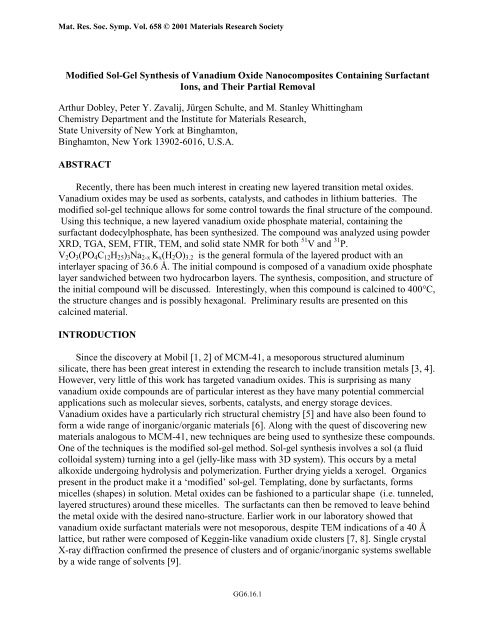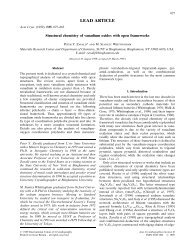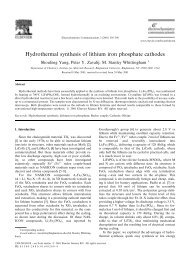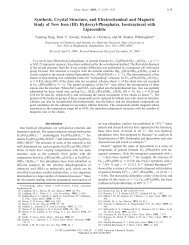Modified Sol-Gel Synthesis of Vanadium Oxide Nanocomposites ...
Modified Sol-Gel Synthesis of Vanadium Oxide Nanocomposites ...
Modified Sol-Gel Synthesis of Vanadium Oxide Nanocomposites ...
You also want an ePaper? Increase the reach of your titles
YUMPU automatically turns print PDFs into web optimized ePapers that Google loves.
Mat. Res. Soc. Symp. Vol. 658 © 2001 Materials Research Society<br />
<strong>Modified</strong> <strong>Sol</strong>-<strong>Gel</strong> <strong>Synthesis</strong> <strong>of</strong> <strong>Vanadium</strong> <strong>Oxide</strong> <strong>Nanocomposites</strong> Containing Surfactant<br />
Ions, and Their Partial Removal<br />
Arthur Dobley, Peter Y. Zavalij, Jürgen Schulte, and M. Stanley Whittingham<br />
Chemistry Department and the Institute for Materials Research,<br />
State University <strong>of</strong> New York at Binghamton,<br />
Binghamton, New York 13902-6016, U.S.A.<br />
ABSTRACT<br />
Recently, there has been much interest in creating new layered transition metal oxides.<br />
<strong>Vanadium</strong> oxides may be used as sorbents, catalysts, and cathodes in lithium batteries. The<br />
modified sol-gel technique allows for some control towards the final structure <strong>of</strong> the compound.<br />
Using this technique, a new layered vanadium oxide phosphate material, containing the<br />
surfactant dodecylphosphate, has been synthesized. The compound was analyzed using powder<br />
XRD, TGA, SEM, FTIR, TEM, and solid state NMR for both 51 V and 31 P.<br />
V 2 O 3 (PO 4 C 12 H 25 ) 3 Na 2-x K x (H 2 O) 3.2 is the general formula <strong>of</strong> the layered product with an<br />
interlayer spacing <strong>of</strong> 36.6 Å. The initial compound is composed <strong>of</strong> a vanadium oxide phosphate<br />
layer sandwiched between two hydrocarbon layers. The synthesis, composition, and structure <strong>of</strong><br />
the initial compound will be discussed. Interestingly, when this compound is calcined to 400°C,<br />
the structure changes and is possibly hexagonal. Preliminary results are presented on this<br />
calcined material.<br />
INTRODUCTION<br />
Since the discovery at Mobil [1, 2] <strong>of</strong> MCM-41, a mesoporous structured aluminum<br />
silicate, there has been great interest in extending the research to include transition metals [3, 4].<br />
However, very little <strong>of</strong> this work has targeted vanadium oxides. This is surprising as many<br />
vanadium oxide compounds are <strong>of</strong> particular interest as they have many potential commercial<br />
applications such as molecular sieves, sorbents, catalysts, and energy storage devices.<br />
<strong>Vanadium</strong> oxides have a particularly rich structural chemistry [5] and have also been found to<br />
form a wide range <strong>of</strong> inorganic/organic materials [6]. Along with the quest <strong>of</strong> discovering new<br />
materials analogous to MCM-41, new techniques are being used to synthesize these compounds.<br />
One <strong>of</strong> the techniques is the modified sol-gel method. <strong>Sol</strong>-gel synthesis involves a sol (a fluid<br />
colloidal system) turning into a gel (jelly-like mass with 3D system). This occurs by a metal<br />
alkoxide undergoing hydrolysis and polymerization. Further drying yields a xerogel. Organics<br />
present in the product make it a ‘modified’ sol-gel. Templating, done by surfactants, forms<br />
micelles (shapes) in solution. Metal oxides can be fashioned to a particular shape (i.e. tunneled,<br />
layered structures) around these micelles. The surfactants can then be removed to leave behind<br />
the metal oxide with the desired nano-structure. Earlier work in our laboratory showed that<br />
vanadium oxide surfactant materials were not mesoporous, despite TEM indications <strong>of</strong> a 40 Å<br />
lattice, but rather were composed <strong>of</strong> Keggin-like vanadium oxide clusters [7, 8]. Single crystal<br />
X-ray diffraction confirmed the presence <strong>of</strong> clusters and <strong>of</strong> organic/inorganic systems swellable<br />
by a wide range <strong>of</strong> solvents [9].<br />
GG6.16.1
EXPERIMENTAL<br />
A modified sol-gel method [10] was used to react a vanadium alkoxide with the surfactant<br />
dodecylphosphate. The air sensitive reagents required the use <strong>of</strong> a double manifold system with<br />
vacuum and argon gas lines, together with ground joint glassware. Also a means <strong>of</strong> cooling the<br />
violent or exothermic reactions is needed, and water or slush baths were used. A reflux set up<br />
was used with a cooling bath <strong>of</strong> ice water to react 5 grams <strong>of</strong> sodium metal (Aldrich) with 300<br />
ml <strong>of</strong> isopropanol (Aldrich) in 300 ml <strong>of</strong> diethyl ether (Aldrich). After completion, the alcohol<br />
and ether were removed by vacuum to leave the white needle like crystals <strong>of</strong> NaOCH(CH 3 ) 2 .<br />
The following synthesis, <strong>of</strong> the vanadium alkoxide, was modified from that <strong>of</strong> Turevskaya [11].<br />
About 250 ml <strong>of</strong> dry diethyl ether was added to the flask with the NaOCH(CH 3 ) 2 , and a dry ice<br />
acetone bath was applied. Then 3.4 ml <strong>of</strong> VCl 4 (Aldrich) was added slowly via a syringe to the<br />
reaction vessel. The resulting NaCl was removed by a fritted filter, and the ether was vacuumed<br />
<strong>of</strong>f to leave V[OCH(CH 3 ) 2 ] 4 . <strong>Vanadium</strong> (IV) isopropoxide was then reacted with acetylacetone<br />
(also known as 2,4-pentanedione from Aldrich) with a 1:1 molar ratio in isopropanol.<br />
Acetylacetone acts as a chelating agent to slow down the hydrolysis reactions <strong>of</strong> the metal<br />
alkoxide. If hydrolysis occurs too fast, then amorphous phases will be obtained. The<br />
isopropanol (iPrOH) was removed by vacuum. A 3.4 wt % aqueous solution <strong>of</strong> the surfactant<br />
was prepared by dissolving dodecylphosphate (from Lancaster <strong>Synthesis</strong> Inc.) into pH 5 adjusted<br />
water (with concentrated HCl). The 3.4 wt % value was due to the addition <strong>of</strong> extra solvent in<br />
order to increase solubility. The reactants, in the molar ratio 1 V[OCH(CH 3 ) 2 ] 4 : 1 acetylacetone<br />
(acac) : 1 surfactant :1 KCl were mixed in a flask for several hours. The contents <strong>of</strong> the flask<br />
were then transferred to a beaker, oven heated at 80 o C for 5 days, washed with water, and then<br />
oven dried at 120 o C for 1day. After drying, the solid crystalline product was black in color<br />
suggesting partial reduction <strong>of</strong> the vanadium. This synthesis scheme is shown in Figure 1.<br />
The material, upon drying, was a black hardened gel with small variations in color. After<br />
grinding it became gray. Initial results from XRD indicated the presence <strong>of</strong> NaCl and KCl salts,<br />
byproducts <strong>of</strong> the synthesis, which were removed by washing with reverse osmosis water.<br />
Samples were characterized via X-ray powder diffraction on a Phillips PW3040-MPD<br />
powder diffractometer using CuKα radiation, fitted with an Anton Parr heating stage model<br />
HTK-10 calibrated to the m.p. <strong>of</strong> lead. Thermalgravimetric analysis, to determine water and<br />
organic content as well as overall stability, was done on a Perkin Elmer TGA 7. Electron<br />
Microprobe analyses and SEM images were obtained using a JEOL 2000 Electron Microprobe.<br />
NMR analysis was performed on a Bruker AVANCE 600 MHz instrument set up for solids.<br />
Concentrated phosphoric acid (aq) was used as a reference for 31 P NMR, and V 2 O 5 was used as<br />
a reference for 51 V (which has a –310 ppm shift in relation to VOCl 3 which is set at 0 ppm) [12].<br />
The FTIR instrument used was a Perkin Elmer 1600 with all <strong>of</strong> the samples being pressed into<br />
KBr pellets. TEM was done on a Hitachi H-7000 Electron Microscope at 125,kV with samples<br />
mounted on a lacey carbon coated copper grid after suspension in an ethanol mixture.<br />
RESULTS<br />
Initial Compound<br />
The powder XRD pattern <strong>of</strong> the initial compound, shown in Figure 2(a) is consistent with a<br />
GG6.16.2
layered structure with approximate d values <strong>of</strong> 37Å, 18Å, 12Å. and 9.7Å. These observed peaks<br />
are in the 00l direction only. This lattice spacing <strong>of</strong> 37Å is consistent with a bilayer <strong>of</strong><br />
surfactant molecules sandwiched between two sheets <strong>of</strong> a vanadium oxide phosphate. No<br />
evidence for residual NaCl or KCl was observed after the washing.<br />
Na(s) + isopropanol<br />
0°C<br />
NaOCH(CH 3 ) 2 + H 2 (g) + heat<br />
vacuum<br />
4 NaOCH(CH 3 ) 2 + VCl 4 + Et 2 O<br />
-78 o C<br />
V[OCH(CH 3 ) 2 ] 4 + 4 NaCl (s)<br />
Filter salt, vacuum<br />
V[OCH(CH 3 ) 2 ] 4 (s)<br />
1 V[OCH(CH 3 ) 2 ] 4 (iPrOH) + 1 acetylacetone (acac)<br />
V[OCH(CH 3 ) 2 ] 3 (acac) + HOCH(CH 3 ) 2<br />
Remove iPrOH under vacuum<br />
V[OCH(CH 3 ) 2 ] 3 (acac) + surfactant (aq) + KCl Å Product<br />
(Heat 80 o C for 5 days, wash with water, 120 o C for 1day)<br />
Figure 1. <strong>Synthesis</strong> scheme.<br />
Relative Intensity<br />
b<br />
a<br />
2 6 10 14 18<br />
2 Theta<br />
Figure 2. The XRD <strong>of</strong> the initial sample at (a) 25°C and (b) 400°C [13].<br />
GG6.16.3
100<br />
90<br />
Weight %<br />
80<br />
70<br />
60<br />
50<br />
40<br />
100 200 300 400 500 600<br />
Temperature o C<br />
Figure 3. TGA <strong>of</strong> initial sample undergoing calcination in oxygen [13].<br />
Thermal gravimetric analysis (TGA) in oxygen (Figure 3) or nitrogen gave a similar curve.<br />
This graph revealed a weight loss <strong>of</strong> around 10% for H 2 O, and about 45% for the hydrocarbon<br />
chain <strong>of</strong> the surfactant. The TGA <strong>of</strong> the surfactant itself showed a steep weight loss around<br />
200°C, which is also seen in the TGA <strong>of</strong> the sample.<br />
The electron microprobe images showed a layered morphology for the material. For use as a<br />
reference in the elemental analysis for the electron microprobe, VOPO 4 was synthesized [14]<br />
and then furnace dried at 500°C for several days. VOPO 4 exhibited a ratio <strong>of</strong> 1.01 P to 1.00 V.<br />
Elemental analysis, by WDS and EDS, <strong>of</strong> the initial compound showed only 4 elements with the<br />
resulting atomic ratio <strong>of</strong> V 1 P 1.5 Na 0.4 K 0.3 . The standard deviation is large for Na and K so there is<br />
probably more than what is written for the ratio given.<br />
<strong>Sol</strong>id state NMR analyses were done on the material for both 51 V and 31 P. Lapina et. al.<br />
extensively investigated 51 V solid state NMR <strong>of</strong> vanadium compounds [12]. They discovered<br />
that the coordination <strong>of</strong> vanadium oxides may be determined, together with the number <strong>of</strong><br />
adjacent vanadium polyhedra from the chemical shift anisotropy (csa) <strong>of</strong> the static solid state<br />
NMR <strong>of</strong> 51 V.<br />
Figure 4. The 51 V static<br />
solid state NMR <strong>of</strong> the<br />
initial sample showing the<br />
chemical shift anisotropy.<br />
The vertical line is caused<br />
by the transmitter <strong>of</strong>fset<br />
[13].<br />
-100<br />
-300<br />
-500<br />
-700<br />
ppm<br />
-900<br />
-1100<br />
-1300<br />
-1500<br />
GG6.16.4
The initial compound had a peak with a range <strong>of</strong> about 350 ppm for static solid state 51 V<br />
NMR. This means a VO 4 tetrahedron has one <strong>of</strong> the oxygens shared with another vanadium<br />
oxide tetrahedron, forming a V 2 O 7 group. A compound with a known structure containing V 2 O 7<br />
groups was also run, and it had a similar range [15]. The MAS NMR for 51 V gave one peak<br />
indicating 1 type <strong>of</strong> vanadium nuclei. Also performed on the sample was 31 P MAS NMR, which<br />
indicated 2 types <strong>of</strong> phosphate nuclei with shifts <strong>of</strong> 0.6 and 25 ppm. The surfactant<br />
dodecylphosphate was analyzed by 31 P MAS NMR, and showed no shift relative to phosphoric<br />
acid. Phosphates are always tetrahedra, and here they form a chain with the vanadia tetrahedra.<br />
FTIR was also used to help elucidate the structure. Vibrations near 2900 cm –1 for the<br />
aliphatic C-H stretch and a P-O stretch at 1111 cm –1 [16] were seen. No vibrations were<br />
observed at 3000 cm –1 for hydroxyl bonded to a P, nor was a peak seen for the O-H stretch for<br />
a hydrogen bonded hydroxyl (which is also bonded to a P) at 2600 cm –1 [16]. The P=O stretch,<br />
which was seen for the dodecylphosphate at 1239 cm –1 , was not seen in the material. So no<br />
P=O or P-O-H bond vibrations were observed. Unfortunately some <strong>of</strong> the vanadium oxygen<br />
bonds occur in the region where the P-O exhibits a strong wide band from 900-1200 cm –1 , so<br />
they were not able to be observed.<br />
TEM images showed a layered morphology with a repeat distance <strong>of</strong> 33 Å. The layers are<br />
stacked on top <strong>of</strong> one another in what appears to be a random method, like sheets <strong>of</strong> paper<br />
stacked, with the sheets at different orientations. Thus the crystals have order in one direction<br />
only, as was seen in the XRD pattern. Several crystals were analyzed and all had a similar<br />
layered appearance.<br />
The proposed structure <strong>of</strong> the initial compound is a bilayer <strong>of</strong> surfactant molecules aligned<br />
with their hydrophobic hydrocarbon ‘tails’ together, and their phosphate ‘heads’ sticking out<br />
and bonded with a layer <strong>of</strong> vanadium oxide giving a 37Å interlayer distance. The experimental<br />
evidence is consistent with the formula V 2 O 3 (PO 4 C 12 H 25 ) 3 Na 2-x K x (H 2 O) 3.2 . The hydrocarbon<br />
chains are covalently bonded to the phosphate tetrahedra, and most likely in the ‘plane’ <strong>of</strong> the<br />
tetrahedra plane (Figure 5). Sodium and potassium cations are bonded to the other oxygens <strong>of</strong><br />
the phosphate. The few water molecules can hydrogen bond to the edges <strong>of</strong> the polyhedra.<br />
Figure 5. The structure <strong>of</strong> the initial compound with the hydrocarbon chains removed for<br />
clarity; the dark tetrahedra are V, and the light tetrahedra are P [13].<br />
GG6.16.5
Calcined Material<br />
Interestingly when the initial compound is heated in air to 400°C, the compound undergoes<br />
a structural change. At this temperature the hydrocarbon portion <strong>of</strong> the surfactant has<br />
combusted; the phosphate remains with the vanadium oxide. This material has phosphate<br />
tetrahedra that are not bonded to hydrogens. The vanadia are tetrahedra that do not share any<br />
oxygens with other vanadium atoms. The V to P ratio is 1 to 1 from electron microprobe<br />
analyses. From the XRD pattern (Figure 2b) the two peaks can be indexed to a hexagonal unit<br />
cell (37 Å (100), 22 Å (110)) and a = 43 Å. More evidence is needed for the elucidation <strong>of</strong> the<br />
unit cell for this material. Further TEM analysis and other experiments will help determine the<br />
structure <strong>of</strong> the calcined material.<br />
ACKNOWLEDGEMENTS<br />
We gratefully acknowledge the National Science Foundation for support <strong>of</strong> this work<br />
through grant DMR-9810198.<br />
We would like to thank David Kiemle, at the S.U.N.Y. College <strong>of</strong> Environmental Science<br />
and Forestry, for use <strong>of</strong> the NMR instrument. Also we thank at Binghamton University, Henry<br />
Eichelberger for use <strong>of</strong> the TEM, and Pr<strong>of</strong>essor David Jenkins for use <strong>of</strong> the x-ray instrument.<br />
REFERENCES<br />
1. J. S. Beck, J. C. Vartuli, W. J. Roth, M. E. Leonowicz, C. T. Kresge, K. D. Schmitt, C. T.-<br />
W. Chu, D. H. Olson, E. W. Sheppard, S. B. McCullen, J. B. Higgins, and J. L. Schlenker,<br />
J. Amer. Chem. Soc., 114, 10834 (1992).<br />
2. J. S. Beck, J. C. Vartuli, G. J. Kennedy, C. T. Kresge, W. J. Roth, and S. E. Schramm,<br />
Chem. Mater., 6, 1816 (1994).<br />
3. Q. S. Huo, D. I. Margolese, U. Ciesla, P. Feng, T. E. Gier, P. Sieger, R. Leon, P. M. Petr<strong>of</strong>f,<br />
F. Schuff, and G. D. Stucky, Nature, 368, 317 (1994).<br />
4. Q. Huo, D. I. Margolese, U. Ciesla, D. G. Demuth, G. D. Stucky, and et.al., Chem. Mater.,<br />
6, 1176 (1994).<br />
5. P. Y. Zavalij and M. S. Whittingham, Acta Cryst., B55, 627 (1999).<br />
6. T. A. Chirayil, P. Y. Zavalij, and M. S. Whittingham, Chem. Mater., 10, 2629 (1998).<br />
7. G. G. Janauer, A. Dobley, J. Guo, P. Zavalij, and M. S. Whittingham, Chem. Mater., 8,<br />
2096 (1996).<br />
8. G. G. Janauer, R. Chen, A. D. Dobley, P. Y. Zavalij, and M. S. Whittingham, Mater. Res.<br />
Soc. Proc., 457, 533 (1997).<br />
9. G. G. Janauer, P. Y. Zavalij, and M. S. Whittingham, Chem. Mater., 9, 647 (1997).<br />
10. D. M. Antonelli and J. Y. Ying, Angew. Chem. Int. Ed. Engl., 34, 2014 (1995).<br />
11. E. P. Turevskaya and N. Y. Turova, Koord. Khim., 15, 373 (1989).<br />
12. Lapina O.B., Mastikhin V.M., Shubin A.A., Krasilnikov V.N., and Zamarev K.I. Progress<br />
in NMR Spectroscopy, 24, 457-525, (1992).<br />
13. A. Dobley, P.Y. Zavalij, J. Schulte, and M. S. Whittingham, Chem. Mater. (submitted).<br />
14. J.W. Johnson, A.J. Jacobson, J.F. Brody and S.M. Rich Inorg. Chem. 21, 3820-2825<br />
(1982).<br />
15. P.Y. Zavalij, F. Zhang, and M. S. Whittingham, Acta Cryst. C53, 1738 (1997).<br />
16. R.T. Conley. Infrared Spectroscopy. (Allyn and Bacon, Inc. Boston 1966).<br />
GG6.16.6








